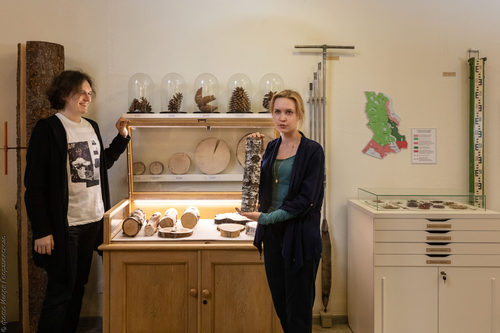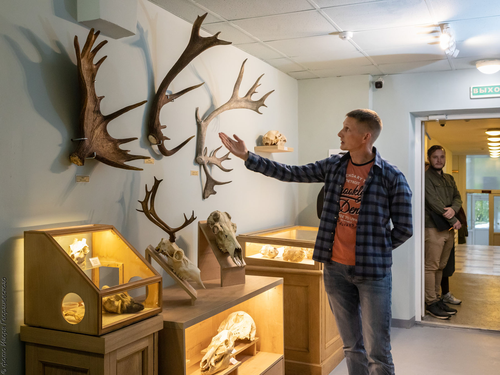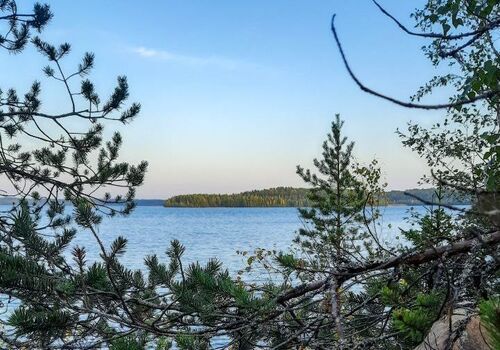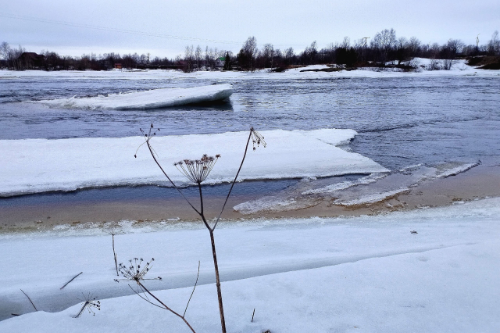– Our museum displays exhibits that tell both about Karelian nature and about the work of scientists: about the research process, mainly in the field and in the laboratory, about the challenges of this quest and the results that we get, – said Olga Bakhmet during the opening ceremony.
According to KarRC RAS leader, the results of many studies by Karelian scientists have been recognized worldwide and it’s important that they are made known not only to Russian and foreign colleagues but also to the general public.

KarRC RAS Director General Olga Bakhmet giving an interview to Karelia broadcasting company correspondent Maria Lukyanova.
The Museum of Applied Environmental Research was created by the Karelian Research Centre RAS in collaboration with the North-Centre Association with funding from Russian Presidential Grant for Civil Society Development. The work started in 2020. Contributions to the making of exhibitions were made by researchers from several KarRC RAS institutes, first of all Forest Research Institute, Institute of Biology, and Northern Water Problems Institute.
The museum is structured into 15 thematic modules, each dedicated to a certain research area: botany, zoology, soil science, forest sciences, water research, etc. Research objects are demonstrated in the modules, including material from expeditions, from the entomological, ornithological, ichthyological, dendrological, herbarium and other collections made by the institutes.

Project manager and executor Alexandra Smirnova and Konstantin Basalaev
Karelian scientists have been doing research in natural sciences ever since the foundation of KarRC RAS in 1946. Museum visitors can see some historical exhibits, including tools, instruments and posters that specialists used in different periods. Apart from items related to research history, the museum demonstrates modern techniques, multimedia and interactive items.
Part of the opening event was a large tour for invited guests, during which scientists introduced some exhibition sections in more detail. In the first room, Senior Researcher at the Laboratory of Plant and Animal Parasitology, Institute of Biology KarRC RAS Anna Sushchuk acquainted the audience with research on nematodes, or roundworms, many of which are dangerous parasites of animals and plants. Senior Researcher at the Forest Soil Science Laboratory, Forest Research Institute KarRC RAS Gulnara Akhmetova inaugurated the soil science module. Researcher at the Laboratory for Landscape Ecology and Forest Ecosystem Protection, Forest Research Institute KarRC RAS Vera Timofeeva shared some details about KarRC RAS Herbarium, which contains tens of thousands of specimens of vascular plants, bryophytes, lichens, and fungi. A special module is dedicated to invasive plant species. Senior Researcher at the Laboratory for Landscape Ecology and Forest Ecosystem Protection, Forest Research Institute KarRC RAS Anna Ruokolainen presented the fungal collection.

Head of Zoology Laboratory, Institute of Biology KarRC RAS Konstantin Tirronen introducing the corresponding thematic module
In the second room, specialists from Zoology Laboratory, Institute of Biology KarRC RAS Konstantin Tirronen and Sergey Simonov guided a tour of the zoological and ornithological modules. Head of the Geography and Hydrology Laboratory, Northern Water Problems Institute KarRC RAS Alexey Tolstikov demonstrated devices used in water research in different periods in the past.
Let us recall that the Karelian Research Center RAS also has the Archaeological Museum of the Institute of Linguistics, Literature and History and the Museum of Precambrian Geology of the Institute of Geology.
- The new museum was created for the Karelian Research Center RAS to get a space where researchers – specialists in natural sciences – can tell schoolchildren, students and everyone interested about their work: about the study objects, methods and tools they use in their work, about things important from the scientific point of view. The museum will offer classical guided tours for groups of schoolchildren and students, meetings with scientists, master classes and other interesting educational activities, - Project Manager Alexandra Smirnova commented.
In the first months of operation visits to the Museum will have to be arranged in advance. Information about admission will soon be available on the Museum page on KarRC RAS website.
Watch a large photo report from the museum opening on VK in KarRC RAS group.
Photos by Igor Georgievski







